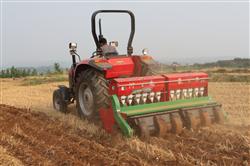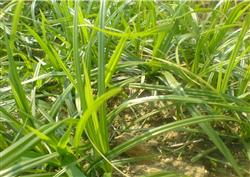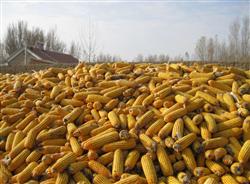How to grow summer corn?

How to grow summer corn? Please give a detailed introduction to the planting of summer corn can refer to the following methods: first, seize the agricultural time, timely and early sow "fighting for the day in spring and fighting for time in summer". The sowing of summer corn should be highlighted and sowed early. Timely early sowing can increase the effective accumulated temperature, prolong the effective growth period of maize, make full use of fertilizer, water, light and heat resources, avoid the effects of "sprout waterlogging" and late low temperature, and achieve full maturity and reduce grain moisture. The sowing time is generally in the first and middle of June, and no-tillage and iron stubble sowing is carried out after the last wheat machinery harvest. In the areas with good agricultural machinery and tools, we strive to complete corn summer sowing on the same day of wheat harvest, so as to achieve "zero agricultural consumption". Second, pay attention to the sowing quality to ensure that the seedlings are as strong as seedlings and seed treatment. Choose and buy seeds that have been coated. If the seed has not been coated, it should be coated with seed coating agent before sowing. 2. Mechanical sowing of iron stubble. Flat sowing is beneficial to mechanical operation and increase the number of ears per mu of corn. The techniques of wheat straw harvesting and no-tillage of corn stubble will be vigorously popularized in flat sowing fields. 3. Ensure soil moisture. Pour enough "wheat yellow water" before wheat harvest to ensure that the soil moisture is sown after wheat harvest. If there is not enough soil moisture when sowing, sprinkler irrigation should be used to irrigate "masked water" in time after sowing. 4. Increase the sowing amount appropriately. In order to ensure a reasonable density, the sowing amount per mu is generally 3 kg, with a minimum of not less than 2 kg, in order to ensure a sufficient number of seedlings. 5. The sowing depth is suitable. In general, for plots with good soil moisture, the sowing depth should be 4cm; when clay or soil is too wet, sowing should be shallow to 3cm; insufficient soil moisture, especially sand, sandy loam and wheat field interplanting plots, should be increased to 6cm. It is required that the sowing depth is the same and the group is neat. 6. Apply fertilizer scientifically. According to the formula of soil testing, balanced fertilization was carried out. Summer sowing corn can make use of the after-effect of organic fertilizer and phosphate fertilizer of winter wheat, and there is no need to apply organic fertilizer and phosphate fertilizer. Pure N 10kg / mu, K2O 10kg / mu, and ZnSO41~1.5 kg / mu in zinc deficient plots. All potash fertilizers were applied at the base, and nitrogen fertilizers were applied at the bottom of 1 to 3 and topdressing with 2 to 3. When using the special long-term release and control fertilizer for corn, it could be applied once at the time of sowing. The base fertilizer and seed fertilizer applied during sowing should be separated from the seed and should not be too close to the seed to prevent fertilizer from "burning seedlings". 7. prevention and control of diseases, pests and weeds. In areas with serious underground pests, insecticide granules such as phoxim are selected to spread poisonous soil or bait for control. The herbicide varieties treated with soil such as atrazine and Acetochlor can be selected to control weeds before sowing, and the herbicide varieties treated with stems and leaves after seedlings can be selected to control weeds at seedling stage. Third, strengthen field management. 1. Reasonable close planting and appropriate increase of density. Check and replenish seedlings in time, replant or transplant with soil in places where there is a serious lack of seedlings and broken ridges. During the 5-leaf expansion period, the seedlings were fixed to ensure a reasonable seedling density, planting about 4000 plants per mu. Some varieties of tall stalk and large panicle type which are not suitable for close planting are generally 3 000 to 3 500 plants per mu, and the density tolerant varieties can be further increased to 4500 or even 5000 plants. In the mid-term management, small plants, weak plants, tillers and empty stalks should be removed in time to reduce the empty consumption of nutrients. 2. Ploughing and topdressing. In the period from jointing to small trumpet mouth (6 leaves to 10 leaves), fertilization was carried out in combination with mid-tillage. Through mid-ploughing, killing wheat stubble to loosen the soil and weed. Topdressing is mainly N fertilizer, not surface application, should be concentrated near the root hole or strip application after deep cover soil, and prevent burning seedlings and improve the utilization rate of chemical fertilizer and so on. 3. Timely drainage and irrigation. During the whole growth period of maize, drought and waterlogging should be tolerated in seedling stage, and waterlogging should be timely drained in case of rainstorm to prevent sprout waterlogging and seedling waterlogging; from booting to filling stage, the demand for water is large, and it is more resistant to waterlogging. In case of drought, timely watering and irrigation can greatly increase the yield of corn. 4. Prevent lodging. On the basis of selecting close planting and lodging resistant varieties, reasonable close planting, fertilization, squatting seedlings, middle ploughing and soil cultivation and removal of small, weak and empty plants were taken to prevent lodging. In the plots with excessive density and serious lodging danger, plant growth regulators can be sprayed in advance to prevent. For example, 50% Aizhuangsu water agent 200 times solution is sprayed before booting. 5. Pest control. The main diseases in summer corn area are leaf spot, stem rot (bacterial wilt), dwarf mosaic disease, and the main pests are corn borer, armyworm, cotton bollworm, aphids, underground pests, thrips and so on. According to the forecast of local diseases and insect pests, prevention and control measures are taken. At present, the common problem of timely harvest is early harvest, resulting in high moisture content (> 40%), low bulk density, many mildew grains and damaged grains, poor commodity quality, affecting yield, quality and price. Through the rational distribution of varieties, early sowing and early management, summer sowing corn can be harvested in time and the yield and quality can be improved. Click to get more corn planting techniques click to get more food crop planting techniques
- Prev

How to control weeds, diseases and insect pests by planting summer corn?
How to control weeds, diseases and insect pests by planting summer corn? Please introduce that summer corn is vulnerable to underground pests such as ground tiger before emergence, gray planthopper, Spodoptera litura, golden needle, thrips, aphids at seedling stage, stem base rot (bacterial wilt), ear rot, leaf spot disease, southern rust and other major diseases at filling stage.
- Next

What problems will affect the yield of summer corn?
What problems will affect the yield of summer corn? Please introduce the following factors that affect the yield of summer corn: first, careless seed selection. As the current seed propagation system is not perfect, unqualified maize seeds still account for a large proportion. Some farmers are greedy for bargains, from small traders or irregular seeds.
Related
- The first cup of black tea in spring, the flavor and history of tea gardens in Kenya, Africa
- The computer can not only choose potatoes, but also grow tea rice. AI will grow winter oolong tea champion.
- It is not only the inflated tea bitten by insects, but also engraved with the four seasons tea in Beipu.
- The Oriental Beauty Tea Festival in Zhuxian County takes the stage at the weekend to experience the plus-size feast of oil tea.
- & quot; Oriental Beauty Tea & Exploration of Emei in Hsinchu, the hometown of quot;
- The new variety of strawberry "Tainong 1" dessert is the first choice with mellow aroma. Crimson gorgeous
- History of Tea in Taiwan: from Wild Inner Mountain to Export Tea Garden
- Two types of Taiwan Oriental Beauty Black Tea won the British three-Star Award for Childhood Tea Xiang Zhang Jiaqi changed from pilot to champion tea maker.
- Banana species and varieties: the planting history of Taiwan Xianren banana and dwarf banana is long, is banana disease resistant?
- Coffee planting Technology: Qianjie Coffee from Seedling to harvesting

